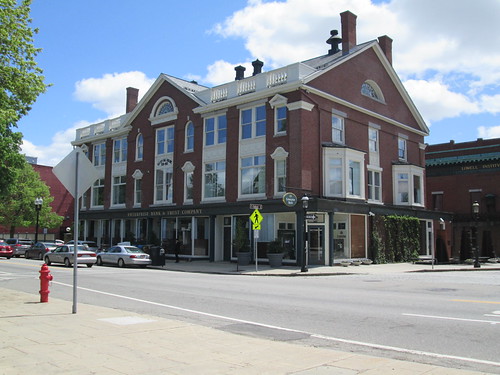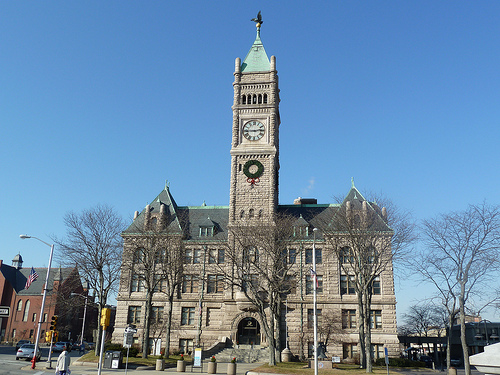History of Charter Change in Lowell

Old City Hall, Lowell’s seat of government from the 1840s to 1890s
Founded as a town in 1826, Lowell’s first governing body was a board of selectmen. The rapid growth of the mills made a city form of government preferable, and so in 1836 the state legislature granted Lowell a city charter.
The city charter brought a new form of government consisting of a City Council made up of a Mayor, six Aldermen and twenty-four Common Councilors. All were elected to one year terms to begin on the first Monday of April each year. The Mayor and the Aldermen were elected citywide, and three Aldermen were elected from each ward.
The Mayor was the chief executive officer of the city, however, he shared executive powers with the six Aldermen, much like a board of selectmen would operate in a town. To enact something legislatively at the city level, both the Aldermen and the Common Council would have to support the measure, so each body had a veto on the acts of the other. There were also six members of the School Committee elected annually to oversee the city’s schools.
Lowell retained this form of government for sixty years, but having executive power spread among so many people proved unwieldly for the still-growing city. In a referendum on the 1896 state election ballot, the voters of Lowell adopted a new charter for the city. The new form of government, set out in chapter 415 of the acts of 1896, transferred executive power in Lowell from the Council to the Mayor, although the Council still had to approve all expenditures.
A dispute immediately arose over whether it was the Mayor or the Council who had the power to make certain governmental appointments (i.e., fill jobs). In his January 1898 inaugural address, incoming Mayor William Courtney complained that the version of the new charter originally put forth by the business community – an effort in which he was a leader – gave the Mayor great authority over city government, but the charter that was enacted, according to Courtney, “was mutilated by a political organization that wanted to hold onto power.” This created confusion as to who appointed whom.

Lowell City Hall, opened in 1898
This new form of government proved unsatisfactory because on November 7, 1911, Lowell residents voted by a margin of 6,856 to 5,563 to adopt an entirely new charter. An outgrowth of the Progressive Movement in America, this new “Commission” form of government was intended to concentrate power in the hands of a small group of experts – Commissioners – who would be chosen by the people.
Lowell’s new government had a Mayor and four Commissioners, all elected to two year terms. All were to be paid $2,500 per year. This five member Commission (the Mayor and the four Commissioners) wielded both legislative and executive power in city government.
Even though their side had prevailed in the polls, the advocates for the new charter sounded like sore losers, claiming that the “thousands who voted against the change were but the dupes of the agents directing the campaign from behind the scenes.” They went on, “Today Lowell is to be congratulated for throwing off the habiliments that stunted her growth. Lowell has joined 160 other progressive cities that have vested the power of government in the people.”
One of the goals of the new form of government was to reduce patronage and increase efficiency. A Lowell Sun editorial stated “Adopting the new charter will create a building and business boom, and will give work to thousands who have remained idle due to deadlocks at City Hall.” This system made it easier to remove commissioners from office, to overturn their actions, or to take actions by referendum. Opponents claimed that Wall Street was behind the new charter movement.
On December 19, 1911 in the first election under the new charter. James O’Donnell (7302 votes) was elected Mayor over Percy Parker (6349), while the four Commissioners elected were Lawrence Cummings (8462), Andrew E Barrett (7426), James E Donnelly (6900), and George Brown (6854). The top two – Cummings and Barrett – had two year terms, while Donnelly and Brown would be up for reelection in just a year so that two of the Commissioners would face the voters every year. Losing Commissioner candidates were Edward Cawley (6522), Clarence Nelson (5624), Charles Hobson (5600), and Royal Dexter (5446). Also elected at this time were five members of the school committee. In this election, women could vote for school committee, but not for Mayor or Commissioners.
In their dual roles as legislators and executives, each Commissioner was given oversight of a particular aspect of city government. Mayor O’Donnell served as Commissioner of Public Safety, James E Donnelly as Commissioner of Finance, George Brown as Commissioner of Streets and Highways, Andrew Barrett as Commissioner of Water Works and Fire Department, and Lawrence Cummings as Commissioner of Public Property and Licenses.
The Commission form of government went into effect in Lowell in January, 1912. A year later, in his annual address, Mayor O’Donnell reviewed the first year of the Commission system. He said that 2 year terms provided continuity of office. Under the new system, “5 men are entrusted with the common interest of all.” He said that because of excessive debt from the prior system, the commission form had been slow to get started.
In practice, the Commission form of government had its own flaws. Individual Commissioners were protective of their own departments and personality disputes through the years made compromise elusive.
Consequently, on November 7, 1922, the people of Lowell voted for another new charter, this one was called Plan B. It won by a 1200 vote margin. Under Plan B, all executive power resided with the Mayor who was elected to a term of two years. There was also a 15 member City Council consisting of 6 councilors elected citywide for two year terms, and 9 ward councilors, each elected to a one year term and each representing a particular ward.
Twenty years later the voters of Lowell had another opportunity to change city government. A city referendum on the ballot for the November 4, 1942 state election asked Lowell residents to change to the Plan E form of government. Plan E was adopted with 16,477 voting for it, and 14,135 voting against.
One factor that may have helped Plan E prevail was that two weeks before this election, the incumbent Mayor of Lowell, George T. Ashe, along with the city’s purchasing agent, Walter S. Connor, were both convicted of conspiracy by a jury in Middlesex Superior Court in Cambridge. The charge involved kickbacks in the purchase of city paving equipment and the padding of bills for paint and other supplies purchased by the city. Ashe was sentenced to one year in the House of Correction although Judge Vincent Brogna stayed the imposition of the sentence pending the resolution of Ashe’s appeal. However, just a month later, Ashe began serving his sentence. He seems to have withdrawn his appeal and also reached a plea agreement for concurrent jail time on an additional charge pending against him of bribery that arose from repairs to the Varnum School.
On November 2, 1943, the city held its first election under Plan E which vested all executive power in a City Manager who would be hired by nine city councilors who were all elected at large by a voting method called proportional representation. Turnout in this elect was 29,000 voter. There were 100 candidates for city council. Because of the nature of the Proportional Representation ballot, the council winners were not determined until Thursday, November 11, 1943. At that point, counting of the school committee ballots commenced.
The new council was inaugurated on Monday, January 3, 1944. At that time, Woodbury Howard, who had led the pro-Plan E movement, was elected Mayor on the second ballot with five votes. Acting Mayor Joseph Sweeney got three votes and William Geary got one. The council cast one ballot for city manager at the inauguration ceremony. Treasurer John Flannery got 4 votes, Attorney John Maguire got 4, and Homer Savage got 1. The council adjourned the election until that night when Flannery got the fifth vote on the first ballot of the evening (Callery, Geary, Sweeney, Hartwell and Roy). Maguire got one vote (from Codrey). Howard and Clement abstained. Scott was in the hospital with appendicitis. Flannery’s background was that he had worked for US Cartridge Co from 1915 to 1927; he had then served as permanent secretary of the Lowell Lodge of Elks from 1927 to 1940, and City Treasurer from 1940 to 1944.
Dissatisfaction soon arose not with Plan E, but with Proportional Representation. On the November 8, 1955 city election ballot, a referendum proposing a switch from proportional representation to plurality representation (all councilors elected citywide by majority vote – our current system) prevailed with 21,498 voting yes to 13,989 voting no. However, one of the incumbent councilors, Samuel Sampson, challenged the legality of the petition in court. Middlesex Superior Court Justice Reuben Lurie agreed with Sampson and invalidated the referendum.
The “out with proportional representation” forces returned two years later. Although the League of Women Voters wanted to retain PR voting, there was a strong movement against it with some elected officials and even individual citizens placing anti-PR ads in the newspaper. For instance, Mary Worthen Duggan of 187 North Llewellyn St signed an ad that said “Vote American: Vote Yes.” Council Candidate William Geary urged scraping PR, saying voting should be simple to understand. He also wrote that PR allows “Communists and fellow travelers” to win in many places. Patrick O’Connor placed an ad that said PR is anti-American and pro-Communist. “We are all Americans. No American citizen should have to flaunt his race to get recognition from voters.”
For whatever reason, the voters of Lowell rejected proportional representation on November 5, 1957, with 21,214 voting yes on the referendum for plurality voting to 12,881 voting no.
Although a Charter Commission was elected in 1969, its proposal to change to a strong mayor form of government was defeated in 1971. Other than a series of non-binding referendum questions on the 1993 city ballot, and an unsuccessful attempt to change back to the proportional representation form of councilor election in 2009 (called “choice voting” at that time), no other attempts have been made to change the city’s form of government via the ballot box since 1957.
Hey Dick – Nice summary, but you again omitted the charter change that was implemented by binding referendum in 1995 to include term limits. The change limited all elected officials in Lowell to 4 2-year terms. Then in 2001, by another binding referendum, term limits was removed from the charter before any elected official was impacted.
Wow, I’ve learned so much from this post.
Some big surprises:
+ In 1911, women could vote for school committee but not city council.
+ In 1943, in the middle of WWII, turnout was 29,000!
+ The argument against proportional representation in the 1950s was openly racist (though I’m guessing the “races” were mostly European ethnic groups) and xenophobic.